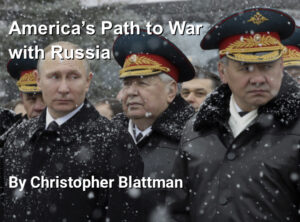Teaching Why We Fight to PhD & Advanced Masters Students
Why We Fight fits well as a unit within a graduate seminar on conflict, international relations, economic development, political economy, or comparative politics.Below are sample syllabi, assignments, slides, videos, and contemporary case studies you can use in class.
x
2–3 Week Unit
I teach conflict theory and empirics in 3–4 lectures of a longer seminar for economics PhD students called Political Economy of Development, with James Robinson [syllabus].
I like to teach a mix of classic theory and very current (often unpublished) papers to give students a feel for both the canon and the frontier.
Here are the lecture slides I used in Spring 2021:
- Rationalist warfare [pdf] [tex] picks up on the material in Chapters 1, 2, 4 and 5
- Non-standard theories of fighting [pdf] [tex] picks up on material in Chapters 2, 3, and 6
- Frontiers of violence research [pdf] [tex] picks up on some of the papers highlighted in Chapters 7-11 of the book
- My other lectures and slides, if you are interested, cover:
Here is an online appendix for the “pie-splitting” examples in the book, in case you want to work through them in class or as a problem set.
Why We Fight is useful a readable and non-technical accompaniment to the academic material. It gives PhD students a better sense of how to apply the theory to historical and contemporary conflicts—something individual academic papers seldom do, and something that can get lost in the game theory.
For slides that are less technical, aimed at undergraduate and masters students, go here.
x
Full course
You could also use the book to structure a full class on the political economy of conflict or an international relations course.
Here’s an article-based version of the class taught in the Harvard Government Department:
I organized my graduate class at Harvard [syllabus] around Why We Fight. We read a chapter a week along with related articles. The great thing about teaching the book is that it organizes an interdisciplinary literature on why violence does and does not occur at every level of analysis—from interstate war to civil wars to street gangs. It clearly articulates theories of war and shows how a host of literatures—both “rationalist” and “behavioral”—can be synthesized within its framework. —Texas A&M political scientist Bill Clark, visiting professor at Harvard Government Department
For a longer and more technical class, I recommend looking to Sandeep Baliga’s Conflict and Cooperation syllabus at Northwestern. A great way to teach the class is to walk through the models in his article with Tomas Sjostrom, Bargaining and War: A Review of Some Formal Models.
x
Assignments
There are a variety of possible assignments:
- For an article-based class, I like to find unpublished working papers on conflict and have students write referee reports on the paper. Or I take more established articles and have them write critical comments. Then we spend the class dissecting the papers.
- Advanced students can work through the game theory. Here is an example problem set with solutions, to help students work through some of the examples in the book. If you want more technical problem sets, reach out. I’d be happy to collaborate on them. T
- If I am teaching this material as a longer unit or full class, I have students work through a contemporary conflict in small groups, and then report back to the class with presentations. See weeks 4–6 of this syllabus for an example.
Overviews of the book
- This Boston Review piece gives the main ideas in about 5000 words
- Teachers and students can also hear summaries of the book on various podcasts or talk about current events though the lens of the book. I recommend these:
- Vox’s Weeds podcast is a good overview
- For loooong 3-hour interviews, check out my talk with the iconic Lex Fridman or the effective altruist 80000 hours podcast
- For videos, here is a 30-minute talk I gave to a Directorate in the U.S. Joint Chiefs of Staff that sums up the book.
- And here is an interview at the U.S. Institute of Peace that I think hits all the big points:
Applying the book to contemporary cases



How to cut short the long slog in Ukraine

America’s Path to War With Russia


The Strategic Logic of Russia’s War on Ukraine





